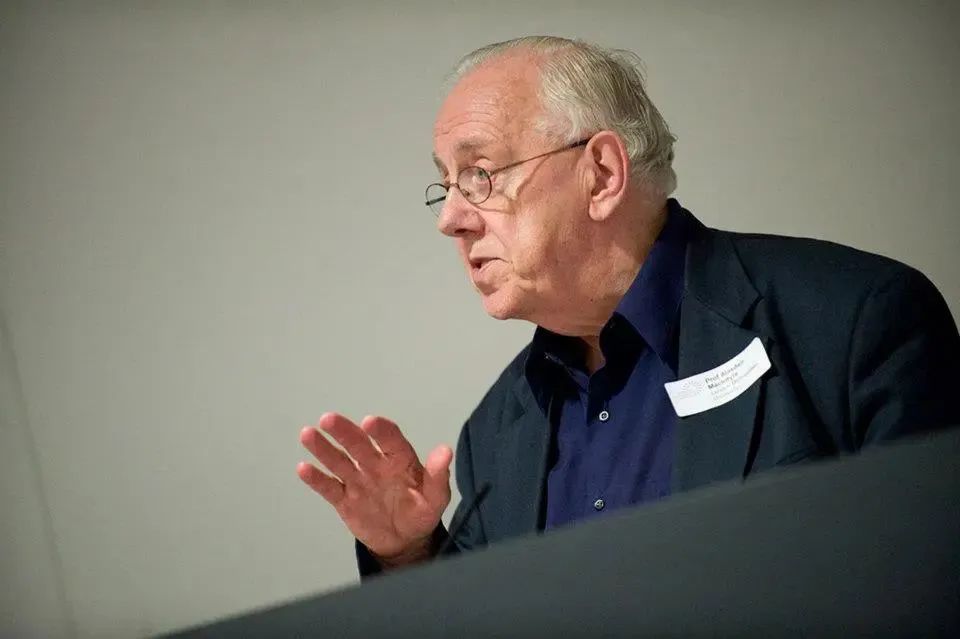
Ethics in the Conflict of Modernity is a book published by the famous ethicist Mai gentile in the late nineties, which is an authoritative exposition of his philosophical thoughts. In this book, Mai gentile thinks that although the modern welfare state has made up for the disadvantages of capitalism to some extent and improved the living standards of most people, it has not fundamentally eliminated the greater disadvantages of capitalism, which often makes people tired and go astray in satisfying their desires, making it difficult to fully balance their interests and maintain a real cooperative life. Mai gentile hopes that people can think and study these problems, understand their social life, know how to negotiate and make correct moral choices, and become practical rationalists.
In this night when countless people revel in consumption, we hope that more people can understand the call of Mai gentile, examine their own desires and pursue a truly happy life.

▲
Mai gentile
Mai gentile: Modernity Suitable for Modern Moral Existence
What is the subject’s desire? How are these desires felt and expressed? How are they related to the subject’s practical reasoning? These problems have changed within the social and cultural order and between different social and cultural orders. Biological needs can be constant, but the objects to satisfy desires will be very different. In Edo in the 19th century, people ate sashimi to satisfy their appetite. In Bologna in the 19th century, people’s appetite was satisfied with salsa sauce. Today, Londoners, who have gained the advantages of many families, also appreciate these two delicacies. But no matter in the past or now, the way people learn to eat at the beginning of their growth will change greatly later. Other needs and demands will also undergo the same transformation. In different social and cultural order, people’s ways to meet their needs and demands run through all kinds of life, with different family and professional roles and corresponding goals, aspirations and hopes. As we mentioned earlier, our desires are always closely linked with our emotions, habits and beliefs, which show different forms in different lifestyles. If we want to understand what is the legitimate reason of desire, we must explore the various functions of desire in those lifestyles, which have the characteristics of the social order and cultural order in which we live, and this is the social order and cultural order of modernity. In this quest, we can mainly consider some obvious problems. Opportunities and hopes, security and poverty, regrets and lamentations, aspirations and other issues all show unique modern forms.These problems come from the continuous transformation of work and are the result of the development of economic modernity since the 18th century.
We start with the question of opportunity and hope. The social and cultural order of modernity, no matter what its form, is the result of long-term economic growth and technological innovation. This long-term nature seems to be indefinite, while the growth is sometimes slow, sometimes fast, sometimes continuous, sometimes disrupted, sometimes deliberately shaped, but in more cases it is unplanned. This growth often provides new types of jobs, sometimes provides people with new opportunities to become managers and professionals, and sometimes brings rich returns to those who can dominate others’ work and occupy their surplus labor value, which often makes workers tolerate the slow growth of wages. As a result, a new system has emerged and the old system has been transformed, and perhaps the most obvious result is that schools have become places to train children and teenagers into labor. In these changes, new types of inequality, new forms of class differentiation, new contradictions and struggles, and new goals of desire and ambition have emerged. We only consider three examples of different types of desire subjects. First, workers in the 19th and 20th centuries were generally employed in mills and factories. These workers are realistic. They mainly want to improve their lives and those of their families. They never want to leave the working class. Secondly, the contemporaries who pursued social and economic success (regardless of social background) had skills, imagination and luck, and wanted to go up through the class system to achieve the success recognized locally at that time. Finally, there are contemporary people with money aspirations. They started from some resources and pursued unlimited wealth. The past and present are not satisfied with this statement.
The first kind of stories are about working-class individuals and families, both of which are the political backbone of the trade union movement throughout its history. Such stories often illustrate the necessity of taking collective action. The second kind of stories provide material for novelists and some sociologists, from which we can study the career structure of the bourgeoisie and see the changes of people at all levels of management, such as engineers or lawyers or newcomers in accounting becoming big coffee in this industry. The third kind of stories are sometimes fables of the rich, but they often record cases of habit addiction, which is an addiction to money. These stories all tell the experiences of some individuals, families and groups. Their life motivation comes not only from ambition and hope, but also from fear of frustration and failure, fear of long-term unemployment and poverty, fear of being unable to get rid of the painful work pressure and fear of debt burden.
With these hopes and fears in the macro sense, individuals have formed the forms of love and hate, harmony and hostility, which make their specific desires, tastes, emotions and habits diverse, such as eating this and not eating that, spending time with these people instead of those people, doing things in this way instead of that way, and being willing to stay here instead of there. Only three types of life are mentioned above, but other types of life are also obviously subject to the hopes and fears brought by capitalism and technological modernity. If all these are carefully studied, we need to describe people’s living situations in large quantities, explain how the subject makes choices in specific situations at each stage of his life, and how to weigh the various objects of desire, that is, regard the satisfaction of some desires only as a means to satisfy others, think that some desires have a high priority compared with others, and may painfully or happily re-examine some of his past choices. If these subjects can reflect on how to best balance their desires and lives, what intellectual, moral and social resources do they have?
In fact, they always lack some urgently needed resources, partly because their thought patterns reflect the characteristics of their living situation and partly because of the constraints of their living situation. Let’s talk about the latter first. The common point of their living situation is that they have changed in different degrees due to the influence of capital flow. At first, capital flow may be creative and productive, or destructive, or both. When capital flow can promote the development and application of new technologies, its role is obviously creative and productive, which will lead to new forms of work, such as iron and steel smelting industry in 18th century, German chemical industry in 19th century, or American information technology industry in 20th century. Capital flow is also very destructive. For example, people in a very mature and stable production mode find that their products have no market, so they suddenly and unexpectedly lose their jobs, have no source of life, and sometimes cut off the way out of their whole lives. However, no matter what people’s living conditions are, the key problem of individuals and their families’ desires lies in the relationship between the salary income they earn and the prices of goods and services they pay. People can’t just think about "what I or we want" or "what I or we should get", but what I or we can afford.
When answering the latter question, people need to constantly evaluate the object of their desire and compare its market value, because the market will change according to the demand. But demand is to satisfy any desire that may exist, and it is the need of self-recognition when people happen to have enough money in their pockets at a certain time and place, whether these needs are real needs or not, and whether these desires are the desires that the subject should satisfy. Economic growth requires people who are engaged in productive work to become consumers. In this way, people who provide goods and services to these consumers shape consumers’ tastes, make their products the object of consumers’ desires, and make consumers feel that anything the economy requires them to consume is their own needs. Therefore, these producers and consumers must be able to distinguish between what is of real value to their lives and prosperity and what is the value induced by the market. However, the market society makes it difficult for working-class and middle-class people to think and negotiate together, which is necessary for them to make the above distinction in their daily decision-making. Why do you see it?
To answer this question, we first need to study the conflicts that have occurred in a long and tangled history, in which there are many obstacles, but as a result, they have promoted economic growth or provided the market with necessities of life. From the protection of traditional rights in the British enclosure movement in the 17th and 18th centuries, to the hand-loom workers’ opposition to the use of mechanized looms to maintain their survival, to the radical trade unions’ actions to demand higher wages and better working conditions, and to the protests of urban community organizations and organizers in Chicago and Boston in the 20th century. Many things in this history should have left a deep impression on us. One of them is that people trapped in this kind of conflict can easily express clearly what they oppose rather than support, and can find all kinds of unjust things sharply and accurately, but they can’t clearly explain the influence and function of these unjust things on the correct understanding of the concept of justice. Therefore, in the face of this constructive and destructive change of modernity, ordinary people trapped in this conflict can rarely think and find an appropriate alternative concept about the direction that social and economic changes should take for themselves, so that they can more fully evaluate the ideas that various political movements have firmly believed since the 18th century.
The problem here is that modernity is used to expressing itself in its own terms, which makes it extremely difficult for people to think about modernity without these terms, so they never leave these terms, and these terms exclude the most needed concepts in radical criticism, making them useless. Therefore, we need to explain the distinctive institutionalized activity patterns and thinking habits in those activity patterns, which enables us to answer two different questions, one is about the specific form and deformation of desire in the context of modernity, and the other is about the way of thinking about our activities and life, which is quite different from modernity, but it is an indispensable element to understand modernity. But before trying to make this explanation, I’d like to make a cautious remark, especially for readers who resent my negative views on modernity.
As far as it has experienced a series of social and political freedom and liberation movements against autocracy and oppression, the history of modernity is indeed a real and admirable history of progress in some key aspects. As far as its great artistic and scientific achievements are concerned-from Raphael to Roscoe, or from Palestrina to Schoenberg, and from Copernicus and Galileo to Feynman and Higgs-the history of modernity is indeed a real and admirable history of progress. What I have said here and elsewhere is not meant to slander. However, this same modernity constantly produces new forms of oppressive inequality, new types of material poverty and spiritual poverty, new setbacks and new misleading of desire. There are many very different stories about modernity, all of which are true, but they all need a unique political and economic framework as the premise.

Ethics in the Conflict of Modernity: On Desire, Practical Reasoning and Narration (Watchman)
Author: Alasdair gentile.
Publication date: May 31, 2021
Press: Renmin University of China Press
Original title: "Mai gentile: We must distinguish what is of real value to our life and prosperity"
Read the original text